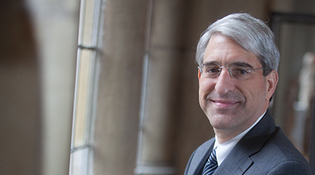 loading
loading
Q&A: Peter SaloveyRoom for scienceYale makes a push for science facilities, new and renovated. The Yale Alumni Magazine regularly holds a conversation with Yale president Peter Salovey ’86PhD to provide a forum in which alumni can learn his views. (Interviews are conducted both in person and by e-mail and condensed for print.)  Mark OstowIn this issue, Salovey talks about the renewed effort to update aging science labs and build new ones. View full imageY: About 20 years ago, Yale started a program of science funding and construction. It was very successful, but then it lagged. You seem to have restarted it—most recently with Wright Lab and the Yale Science Building. S: To realize Yale’s mission of improving the world today and for future generations, we must push the frontiers of knowledge, and this includes advancing our understanding of and increasing our impact in science and engineering. I am excited that we are making bold investments, rejuvenating old facilities, and building new ones on Science Hill. Along with improved laboratories and teaching spaces, we will continue to bring the world’s top scientists to Yale and offer the best teaching and learning environment to our students. We have the opportunity to pursue world-changing scientific research and offer a best-in-class education. When I became president, we launched a series of projects that had been in preliminary planning phases for a long time. The first one focused on the Sterling Chemistry Laboratory, both the research and the teaching spaces. I am especially proud of the superb teaching laboratories that we opened earlier this year. Students used to say to me that the laboratories in their high schools—and not just in affluent school districts—were better equipped than so many of the old teaching labs on Science Hill. I remember seeing fume hoods in SCL that were trimmed in oak! At one of my first meetings with the provost, I said, “Let’s put the SCL teaching labs at the top of the list.” I wanted to make a statement: science education is central to Yale’s mission. The Sterling Chemistry building now houses teaching laboratories for chemistry as well as biology and physics. Increasingly, we are designing buildings and planning renovations that promote interdisciplinary interaction and collaboration, leading to extraordinary new ideas, cutting-edge research, and innovative teaching. The boundaries between scientific fields more generally have frayed, and our projects reflect this change. We recently cut the ribbon on the Yale Wright Laboratory, where a particle accelerator was housed for many years before it recently was decommissioned and removed. The Wright Lab is built like an underground bunker, and it is enormous. In the Wright Lab, cosmology, astrophysics, and nuclear and particle physics all come together in studies of the invisible universe. Investigators are asking the fundamental questions that connect the largest structures of the universe to its smallest constituents—neutrinos, dark matter, and black holes. As with other new science facilities, both teaching and research take place in the Wright Lab. Investigators can bring students into their laboratories to experience scientific inquiry in real time. The classrooms are wonderful, and there are incredible machine shops, where students can learn to fabricate their own scientific equipment. Y: Is that becoming common now? S: Yes. Often you need a specialized piece of equipment that cannot be purchased off the shelf. Being able to create customized tools and instruments changes your relationship to the research itself; it creates the freedom to pursue many more options. So the Wright Lab machine shops are designed for investigators and for student instruction. Y: There’s also the Yale Science Building now going up. S: That project has been dreamed about for probably two or three decades, and this huge building is now rising from the earth. It will house all of one biology department and part of another, some physics, and the Quantitative Biology (QBio) Institute. And again, research and teaching will be carried out under the same roof. The ground floor will include one of the best lecture halls on campus. We will be able to use this new space for courses from off the Hill, too. Introductory psychology students, for example, might attend a lecture and notice biology, chemistry, and physics research happening nearby—and perhaps be intrigued. We are creating much more of a community on Science Hill. We are redesigning the Science Hill quadrangle so that it facilitates interactions. Paths among the buildings, including the Peabody Museum, will be much more obvious. Placed between the Kline Biology Tower and the new Yale Science Building will be a pavilion—a place where faculty and students come together for lunch, for a coffee break, to study, or just to hang out. We want faculty and students to bump into each other and spend time with each other. Y: What’s in the future? S: We will be developing a plan for the Kline Biology Tower. We want to find ways to create more interconnectivity among the floors, so it feels less like a tower and is better integrated for faculty and other researchers working there. More broadly, we are thinking strategically about science in its entirety at Yale. Science Hill largely houses members of the Faculty of Arts and Sciences. But when we talk about science at Yale, we mean the whole campus—science in the School of Medicine, School of Engineering and Applied Science, School of Nursing, School of Forestry and Environmental Studies, School of Public Health, Peabody Museum, West Campus, and elsewhere. We will be investing in fields where Yale can be unsurpassed—where we can have world-altering impact.
The comment period has expired.
|
|